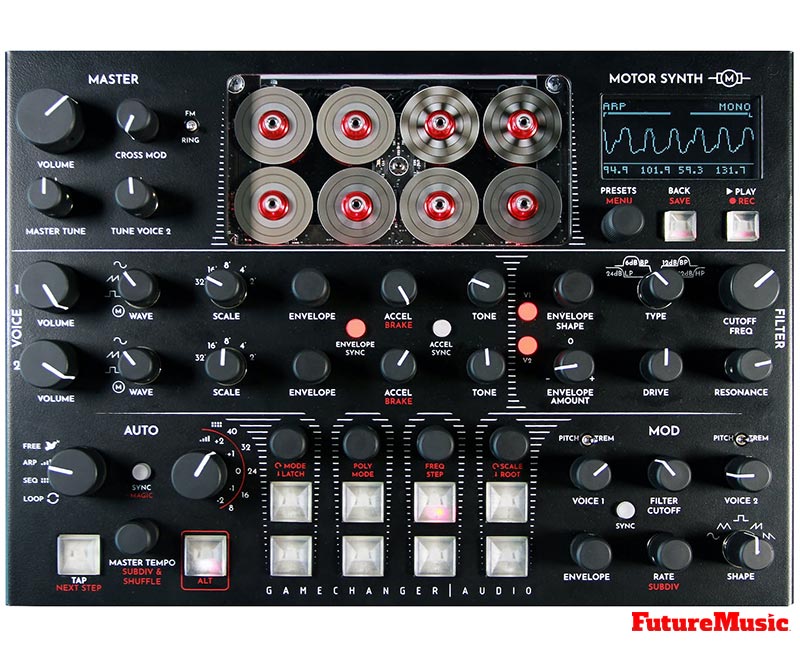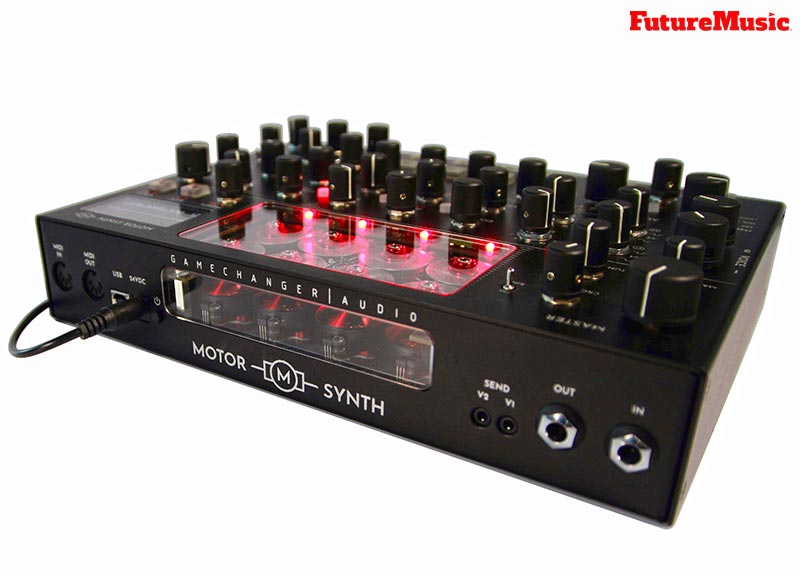Gamechanger | Audio, one of several exciting companies to emerge on the synth scene from Latvia, has officially debuted their provocative Motor Synth, a digitally-controlled, analog electro-mechanical synthesizer that uses a system of electromotors as its main sound source. The Electromotors convert electrical energy into mechanical energy to create sound.

Motor Synth produces sounds by accelerating and decelerating eight electromotors to precise RPM (revolutions per minute) that correspond with specific musical notes. The instrument’s eight-electromotor configuration means that it is a four-note, polyphonic synth with two voices per key played. Motor Synth takes a two-pronged approach to producing its core sound, starting with magnetic pickups placed on each of its eight electromotors; those electromotors’ spinning coils result in an industrial-sounding, over-the-top analog tone. Think eight harmonious revving engines pumping out an intimidating noise! Next, specially-designed reflective optical disks have been attached to the shafts of each electromotor. Each disk contains a graphical representation of some standard audio wave-shapes. As the electromotors spin, the disks are set into circular motion, and each wave-shape is read by a dedicated set of UV (ultraviolet) sensors, then converted into an audio signal. So the wave-shapes on the reflective optical disks become precise musical notes, corresponding to the speed of the electromotors.
Motor Synth still features familiar analog audio processing circuits, including filters, envelopes, arpeggiation, cross-modulation sequencing, and multiple polyphonic mode facilities, as well as an innovative looping system that allows adventurous users to layer rhythm and melodies.

Motor Synth is a desktop design and can be played out of the box via eight built-in control keys and four floating tuning pots. Performers and composers can connect any standard MIDI controller, and Motor Synth can also track a monophonic audio signal, such as guitar or bass, via its 1/4-inch mono input. Interestingly, Motor Synth can be configured to act as a harmonizer for electric guitars or other melodic instruments, recognizing the pitch of a musical tone and instantly generating a complimentary tone by operating an electromotor at a matching frequency. Furthermore, users can create intervals and chords based on the frequency of the incoming signal with no need (necessarily) for a MIDI controller or inputting preprogrammed musical information.
Motor Synth’s see-through protective glass cover above its core sound system of eight electromotors enables users to receive visual feedback from the instrument itself by being able to see those spinning electromotors in action. But better still, the visual experience is enhanced still further by the also-visible set of reflective optical disks attached to the electromotors’ shafts being coupled to a set of eight mini strobe lights, so those spinning disks themselves turn into a hypnotic light show, courtesy of the strobe effect!
As an instrument that uses electromotors as its main sound source, Motor Synth inherently possesses many unique sound traits that will surely appeal to many musicians that enjoy analog synthesizers in particular. Put it this way: with its unusual tonal and timbral qualities, unlimited microtonal pitch adjustment and modulation abilities, and note attack and decay properties influenced by the acceleration and deceleration curves of electromotors, Motor Synth works well across a wide range of musical styles.
No pricing has been announced. Gamechanger intends to fund the Motor Synth via an Indiegogo campaign.
Gamechanger | Audio








